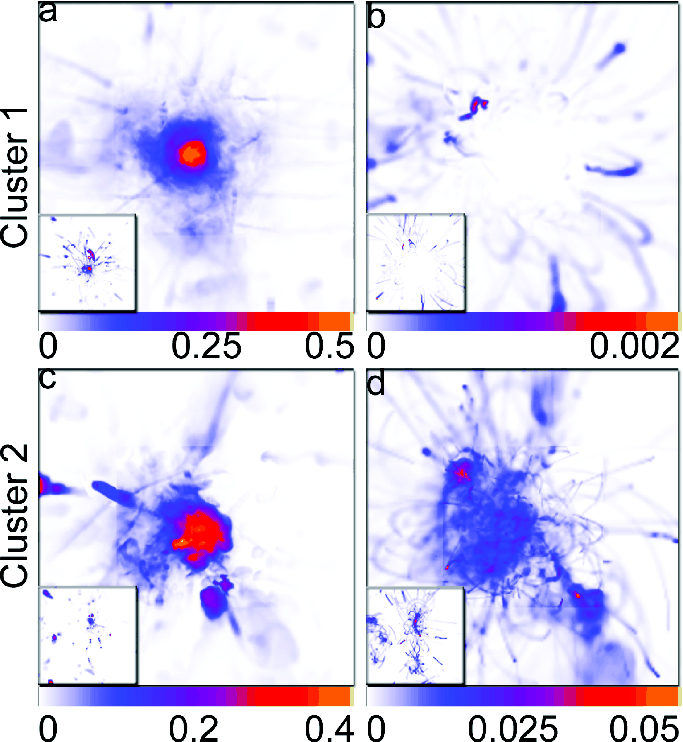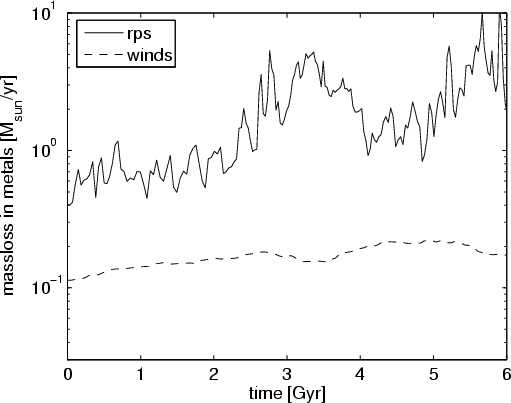ICM
Metal enrichment processes in the intra-cluster medium
S. Schindler, W. Kapferer, W. Domainko, M.Mair, E. van Kampen, T. Kronberger, S. Kimeswenger, M. Ruffert, O. Mangete, and D. Breitschwerdt
Overview
This paper discusses simulations of galaxy clusters in order to investigate the process of enriching inter-cluster gas by injecting interstellar gas though ram-stripping and galactic winds. They compare their results with X-ray observations of, both showing inhomogeneity in the metallicity of the gas.
Summary:
In clusters, interstellar medium gas (ISM) is removed from galaxies and enriches the intra-cluster medium (ICM). There are variety of processes that can strip gas from a galaxy, but this paper concentrates on stripping due to ram-pressure and galactic winds. They create a simulation of that considers several scenarios for enrichment in the ICM. They consider two different galaxy clusters, a massive one that undergoes small mergers, and a less massive cluster that undergoes a major merger. Since they are only considering enrichment due to galactic winds and ram-pressure, they do not consider starburst galaxies, but rather a constant star formation rate.
Figure 1 shows the results of both clusters where Cluster 1 is the more massive cluster and Cluster 2 is the less massive cluster. Panel a) illustrates the metallicity of the ICM due to ram-pressure stripping and panel b) is metallicity enhancement due to galactic winds for the more massive, minor-merger cluster. Panel c) and d) are the same as a) and b) but for the less massive major merging cluster. They find that ram-pressure stripping produces a concentrated metallicity distribution while galactic winds produce a more extended distribution of metallicity. In Cluster 2, they find that the galactic winds are less suppressed and the metallicity is very inhomogeneous and can be seen as strips of more metal rich gas.
In Figure 2 they plot the evolution of massloss of metals from the host galaxies over 6 Gyrs due to ram-pressure stripping and galactic winds. Winds cause a nearly smooth massloss while ram-pressure mass loss is very chaotic. Ram-pressure stripping is able to remove large amounts of gas over short time scales, especially during merging events. However, in environments with large ICM density (Cluster 1), galactic winds are suppressed, which can be seen in figure 1, panel b.


Question to Author
How did the massloss from ram-pressure and galactic winds scale for Cluster 1?
Follow-up Research Project Idea
Change code to as star-burst galaxies and see how that compares to massloss from ram-pressure stripping.
Cume Question
Describe ram-pressure stripping. What pressures, roughly, might be applied to a galaxy inn this cluster?
Ram-pressure stripping is the stripping of interstellar gas from a galaxy due to the pressure a galaxy feels as it moves through inter-cluster gas
Pressure = density * v^2
density is the density of fluid objected in contained in. V can be velocity of object or fluid.
Density = 6x10^-27 g/cm^3 listed in paper
v ~ 1x10^9 cm/s
P = 6x10^-9 g/(cm*s)
Ties to Class Material
We discussed galactic winds as observed in star-burst galaxies such as M82.
